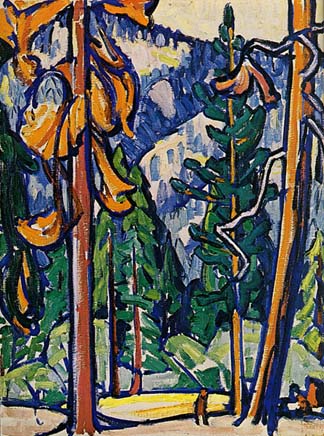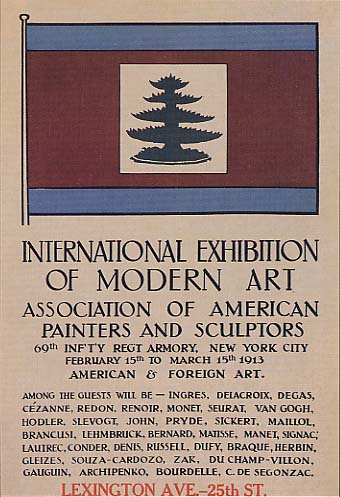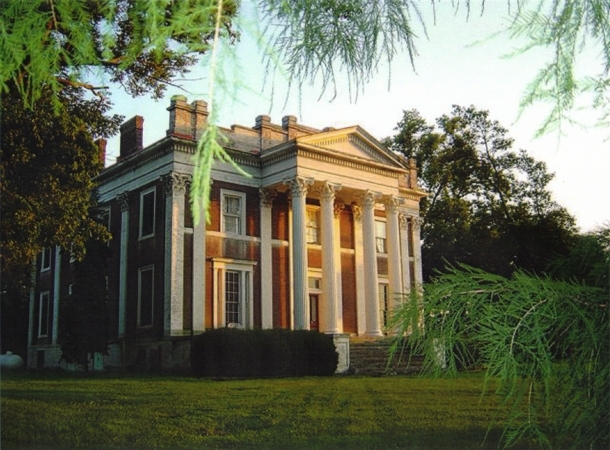|
Myra Musselmann-Carr
Myra Musselman-Carr (November 27, 1871 or 72 or 1880–1929) American sculptor born in Georgetown, Kentucky She studied first at the Art Academy of Cincinnati in Cincinnati, Ohio, then in New York City at the Art Students League and finally with Antoine Bourdelle in Paris. She is believed to have been an early proponent of the direct carving method of sculpting. Around 1915 to 1917 she founded the Modern Art School in New York and taught sculpture there, alongside co-founders and painting teachers Marguerite Zorach and William Zorach. Armory Show of 1913 Musselman-Carr was one of the artists who exhibited at this important show which included two of her bronze statuette A figurine (a diminutive form of the word ''figure'') or statuette is a small, three-dimensional sculpture that represents a human, deity or animal, or, in practice, a pair or small group of them. Figurines have been made in many media, with cl ...s entitled ''Electra'' ($50) and ''Indian grinding corn ... [...More Info...] [...Related Items...] OR: [Wikipedia] [Google] [Baidu] |
Sculpture
Sculpture is the branch of the visual arts that operates in three dimensions. Sculpture is the three-dimensional art work which is physically presented in the dimensions of height, width and depth. It is one of the plastic arts. Durable sculptural processes originally used carving (the removal of material) and modelling (the addition of material, as clay), in stone, metal, ceramic art, ceramics, wood and other materials but, since Modernism, there has been an almost complete freedom of materials and process. A wide variety of materials may be worked by removal such as carving, assembled by welding or modelling, or Molding (process), moulded or Casting, cast. Sculpture in stone survives far better than works of art in perishable materials, and often represents the majority of the surviving works (other than pottery) from ancient cultures, though conversely traditions of sculpture in wood may have vanished almost entirely. However, most ancient sculpture was brightly painted, ... [...More Info...] [...Related Items...] OR: [Wikipedia] [Google] [Baidu] |
Marguerite Zorach
Marguerite Zorach (née Thompson; September 25, 1887 – June 27, 1968) was an American Fauvist painter, textile artist, and graphic designer, and was an early exponent of modernism in America. She won the 1920 Logan Medal of the Arts. Early life Marguerite Thompson was born in Santa Rosa, California. Her father, a lawyer for Napa Valley vineyards, and mother were descended from New England seafarers and Pennsylvania Quakers. While she was young, the family moved to Fresno and it was there that she began her education. She started to draw at a very young age and her parents provided her with an education that was heavily influenced by the liberal arts, including music lessons in elementary school, and four years of Latin at Fresno High School. She was one of a small group of women admitted to Stanford University in 1908. Career Paris and travel While at Stanford, Thompson continued to show aptitude for art, and rather than completing her degree, she traveled to France at the ... [...More Info...] [...Related Items...] OR: [Wikipedia] [Google] [Baidu] |
19th-century American Sculptors
The 19th (nineteenth) century began on 1 January 1801 ( MDCCCI), and ended on 31 December 1900 ( MCM). The 19th century was the ninth century of the 2nd millennium. The 19th century was characterized by vast social upheaval. Slavery was abolished in much of Europe and the Americas. The First Industrial Revolution, though it began in the late 18th century, expanding beyond its British homeland for the first time during this century, particularly remaking the economies and societies of the Low Countries, the Rhineland, Northern Italy, and the Northeastern United States. A few decades later, the Second Industrial Revolution led to ever more massive urbanization and much higher levels of productivity, profit, and prosperity, a pattern that continued into the 20th century. The Islamic gunpowder empires fell into decline and European imperialism brought much of South Asia, Southeast Asia, and almost all of Africa under colonial rule. It was also marked by the collapse of the large S ... [...More Info...] [...Related Items...] OR: [Wikipedia] [Google] [Baidu] |
American Women Sculptors
American(s) may refer to: * American, something of, from, or related to the United States of America, commonly known as the "United States" or "America" ** Americans, citizens and nationals of the United States of America ** American ancestry, people who self-identify their ancestry as "American" ** American English, the set of varieties of the English language native to the United States ** Native Americans in the United States, indigenous peoples of the United States * American, something of, from, or related to the Americas, also known as "America" ** Indigenous peoples of the Americas * American (word), for analysis and history of the meanings in various contexts Organizations * American Airlines, U.S.-based airline headquartered in Fort Worth, Texas * American Athletic Conference, an American college athletic conference * American Recordings (record label), a record label previously known as Def American * American University, in Washington, D.C. Sports teams Soccer * B ... [...More Info...] [...Related Items...] OR: [Wikipedia] [Google] [Baidu] |
1871 Births
Events January–March * January 3 – Franco-Prussian War – Battle of Bapaume: Prussians win a strategic victory. * January 18 – Proclamation of the German Empire: The member states of the North German Confederation and the south German states, aside from Austria, unite into a single nation state, known as the German Empire. The King of Prussia is declared the first German Emperor as Wilhelm I of Germany, in the Hall of Mirrors at the Palace of Versailles. Constitution of the German Confederation comes into effect. It abolishes all restrictions on Jewish marriage, choice of occupation, place of residence, and property ownership, but exclusion from government employment and discrimination in social relations remain in effect. * January 21 – Giuseppe Garibaldi's group of French and Italian volunteer troops, in support of the French Third Republic, win a battle against the Prussians in the Battle of Dijon. * February 8 – 1871 French legislative election elect ... [...More Info...] [...Related Items...] OR: [Wikipedia] [Google] [Baidu] |
Statuette
A figurine (a diminutive form of the word ''figure'') or statuette is a small, three-dimensional sculpture that represents a human, deity or animal, or, in practice, a pair or small group of them. Figurines have been made in many media, with clay, metal, wood, glass, and today plastic or resin the most significant. Ceramic figurines not made of porcelain are called terracottas in historical contexts. Figures with movable parts, allowing limbs to be posed, are more likely to be called dolls, mannequins, or action figures; or robots or automata, if they can move on their own. Figurines and miniatures are sometimes used in board games, such as chess, and tabletop role playing games. The main difference between a figurine and a statue is size. There is no agreed limit, but typically objects are called "figurines" up to a height of perhaps , though most types are less than high. Prehistory In China, there are extant Neolithic figurines. European prehistoric figurines of wome ... [...More Info...] [...Related Items...] OR: [Wikipedia] [Google] [Baidu] |
Armory Show Of 1913
The 1913 Armory Show, also known as the International Exhibition of Modern Art, was a show organized by the Association of American Painters and Sculptors in 1913. It was the first large exhibition of modern art in America, as well as one of the many exhibitions that have been held in the vast spaces of U.S. National Guard armories. The three-city exhibition started in New York City's 69th Regiment Armory, on Lexington Avenue between 25th and 26th Streets, from February 17 until March 15, 1913. The exhibition went on to the Art Institute of Chicago and then to The Copley Society of Art in Boston,International Exhibition of Modern Art catalogue cover, Copley Society of Boston, |
William Zorach
William Zorach (February 28, 1889 – November 15, 1966) was an American sculptor, painter, printmaker, and writer. He won the Logan Medal of the arts. He is notable for being at the forefront of American artists embracing cubism, as well as for his sculpture. He is the husband of Marguerite Thompson Zorach and father of Dahlov Ipcar, both artists in their own right. Early life Zorach Gorfinkel was born in 1889 into a Lithuanian Jewish family, the son of a barge owner, in Jurbarkas (russian: link=no, Eurburg) in Lithuania (then a part of the Russian Empire) As the eighth of ten children, Zorach (then his given name) emigrated with his family to the United States in 1894. They settled in Cleveland, Ohio under the name "Finkelstein". In school, his first name was changed to "William" by a teacher. Zorach stayed in Ohio for almost 15 years pursuing his artistic endeavors. He apprenticed with a lithographer as a teenager and went on to study painting with Henry G. Keller in night s ... [...More Info...] [...Related Items...] OR: [Wikipedia] [Google] [Baidu] |
Direct Carving
This page describe terms and jargon related to sculpture and sculpting. __NOTOC__ A armature :An armature is an internal frame or skeleton which supports a modelled sculpture. A typical armature for a small sculpture is made of heavy gauge wire, bent and twisted to form the basic shape. Often the armature is designed to leave one or more pins protruding from the base of the finished sculpture to facilitate attaching it to the plinth additive : Is the process by which material is shaped and built up, frequently on an armature, to create the desired image. Traditionally the material used in modeling clay, but plaster is considered a less desirable but also less expensive substitute. Frequently the sculpture created by the additive method is a temporary one, used to create a more permanent version in stone or bronze. assemblage :An assemblage is a sculpture constructed from found objects. Typically an assemblage does not disguise the original objects used, rather it e ... [...More Info...] [...Related Items...] OR: [Wikipedia] [Google] [Baidu] |
Georgetown, Kentucky
Georgetown is a home rule-class city in Scott County, Kentucky, United States. The population was 37,086 at the 2020 census. It is the 6th-largest city by population in the U.S. state of Kentucky. It is the seat of its county. It was originally called Lebanon when founded by Rev. Elijah Craig and was renamed in 1790 in honor of President George Washington. It is the home of Georgetown College, a private liberal arts college. Georgetown is part of the Lexington-Fayette, KY Metropolitan Statistical Area. At one time the city served as the training camp home for the NFL's Cincinnati Bengals. The city's growth began in the mid-1980s, when Toyota built Toyota Motor Manufacturing Kentucky, its first wholly owned United States plant, in Georgetown. The plant opened in 1988; it builds the Camry, Camry Hybrid, Avalon, Lexus ES, and RAV4 Hybrid automobiles. History Native peoples have lived along the banks of Elkhorn Creek in what is now Scott County for at least 15,000 years. A ... [...More Info...] [...Related Items...] OR: [Wikipedia] [Google] [Baidu] |
Paris, France
Paris () is the Capital city, capital and List of communes in France with over 20,000 inhabitants, most populous city of France, with an estimated population of 2,165,423 residents in 2019 in an area of more than 105 km² (41 sq mi), making it the List of cities proper by population density, 30th most densely populated city in the world in 2020. Since the 17th century, Paris has been one of the world's major centres of finance, diplomacy, commerce, Fashion capital, fashion, gastronomy, and science. For its leading role in the arts and sciences, as well as its very early system of street lighting, in the 19th century it became known as "the City of Light". Like London, prior to the Second World War, it was also sometimes called Caput Mundi#Paris, the capital of the world. The City of Paris is the centre of the Île-de-France Regions of France, region, or Paris Region, with an estimated population of 12,262,544 in 2019, or about 19% of the population of France, making the ... [...More Info...] [...Related Items...] OR: [Wikipedia] [Google] [Baidu] |
Antoine Bourdelle
Antoine Bourdelle (30 October 1861 – 1 October 1929), born Émile Antoine Bordelles, was an influential and prolific French sculptor and teacher. He was a student of Auguste Rodin, a teacher of Giacometti and Henri Matisse, and an important figure in the Art Deco movement and the transition from the Beaux-Arts style to modern sculpture. His studio became the Musée Bourdelle, an art museum dedicated to his work, located at 18, rue Antoine Bourdelle, in the 15th arrondissement of Paris, France. Early life and education Émile Antoine Bourdelle was born at Montauban, Tarn-et-Garonne in France on 30 October 1861. His father was a wood craftsman and cabinet-maker. In 1874, at the age of thirteen, he left school to work in his father's workshop, and also began carving his first sculptures of wood. In 1876, with the assistance of writer Émile Pouvillon, he received a scholarship to attend the School of Fine Arts in Toulouse, though he remained fiercely independent and resisted the ... [...More Info...] [...Related Items...] OR: [Wikipedia] [Google] [Baidu] |



_(LOC)_-_Flickr_-_The_Library_of_Congress.jpg)






